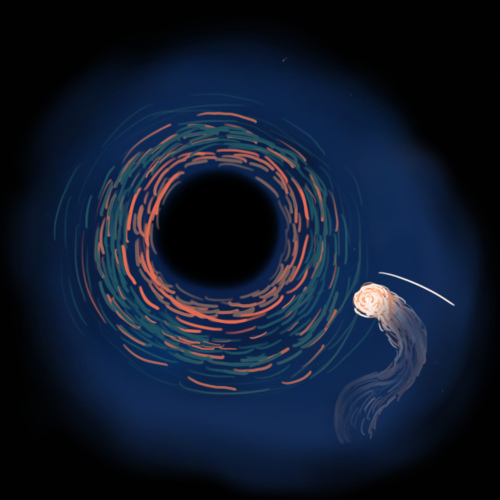Art Courtesy of Yurou Liu
Most of the stars we see in the night sky are billions of years old, their light only just now reaching us from light-years away. But what lies beyond what we can see? The reach of the universe extends far beyond the stars that we’re able to observe with the naked eye.
A team led by Florian Peißker, a postdoctoral researcher at the University of Cologne’s Institute of Astrophysics in Germany, recently discovered a newborn star named X3 whose existence defies all odds. Dubbed “the impossible star,” X3 is located over twenty-five thousand light-years away and is currently undergoing early stages of stellar formation in the vicinity of Sagittarius A*, the supermassive black hole at the heart of our galaxy. Star formation so close to a black hole was thought to be theoretically impossible, but X3 persists all the same.
“I enjoy thinking about the opportunity to witness processes nobody else has seen before,” Peißker said. The paper, published in The Astrophysical Journal, is the product of two and a half years of work and explores how X3 was able to form in spite of Sagittarius A*.
Star formation typically requires two conditions: relatively low temperatures and high gas density, neither of which holds true for the environments created by black holes. The area that Sagittarius A* occupies, known as the Galactic Center, is extremely hot and volatile.
“This source should not exist in the first place because of the harsh environment of the supermassive black hole Sagittarius A*,” Peißker said. “The fact that we observe such a young object so close implies that this is not the only [such object]. It furthermore shows that star formation can occur, although the classical criteria are not fulfilled.”
Previous research in the field identified clumps of silicon monoxide (SiO) gas near Sagittarius A* that may have been dense enough to permit high-mass star formation. A study in 2014 suggested that these clumps originated from the Circumnuclear Disk (CND), a ring of molecular gas that surrounds Sagittarius A*. It was proposed that some SiO clumps found within the CND either had high enough velocity gradients or had experienced a sufficient decrease in angular momentum to spiral closer to Sagittarius A* than would be otherwise possible. This process, called molecular cloud inspiraling, was thought to be part of what could foster stellar formation so close to a black hole.
The team behind Peißker’s study sought to build upon this work. They compiled data on X3 spanning three decades from four different telescopes, including the Very Large Telescope in Chile, to better map out the X3 system and its surroundings. The team divided the X3 system into three components—designating the young stellar object as X3a and two neighboring thermal blobs as X3b and X3c—and collected data about nearby stars and gas clusters. The analysis helped the team confirm the star’s proximity to Sagittarius A* and better understand its origins by examining its characteristics.
In addition to the accretion of the SiO gas clumps discussed in previous research, the team believes that rotating regions of dust and gas in the Galactic Center, called stellar disks, may also have been key to X3’s formation. The thickness of these disks would have been sufficient to lower the temperature within the region for star formation to be feasible, while simultaneously protecting the area from the black hole’s radiation.
As they rotate, these stellar disks become dense enough to create massive gas clusters conducive to high-mass stellar formation. The team believes that one of these clusters, IRS 13, was instrumental to the formation of the X3 system. Based on the team’s data points, the timeline for this formation theory aligns with our current understanding of this region’s stellar history.
Peißker was excited upon confirming X3’s proximity to Sagittarius A*, but joked that the process of discovery was far more prolonged than an ordinary surprise reaction. “For six months, I ran day-in and day-out simulations to fit the data points,” Peißker said. “Back then, my daughter demanded milk almost every three hours each night. So I woke up, gave baby milk to my daughter, and started simulations with the new parameters. I did this around the clock.”
Peißker hopes to build upon this work in the future to learn more about how the mechanisms of stellar formation respond to unconventional situations, which could lay the groundwork for a richer understanding of star evolution and our universe at large.

